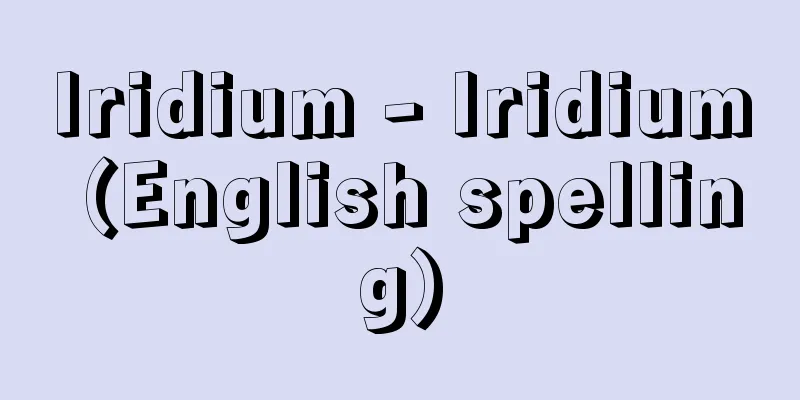Iridium - Iridium (English spelling)

|
It belongs to group 9 of the periodic table and is one of the platinum group elements. It was discovered in 1804 by S. Tennant of England. It was named after Iris, the Greek goddess of the rainbow, because aqueous solutions of its salts come in a variety of colors. It exists in platinum ore as a natural alloy (iridosmine) or in free form, but is also found in trace amounts in copper sulfide and nickel sulfide ores. After platinum ore or anode mud from copper-nickel electrolytic refining is treated with aqua regia, it is separated from the insoluble residue as a halogeno complex salt. When this is heated in a hydrogen stream, pure metallic iridium is obtained by the following reaction:
natureA silvery-white metal. It is hard, brittle, and difficult to work with. It is second only to osmium in the platinum group in terms of hardness and high melting point. It also has the highest specific gravity of any substance in existence. It has many radioactive isotopes with mass numbers ranging from 185 to 198. A typical precious metal, its lumps are insoluble in all acids, even aqua regia. It can only be dissolved in aqua regia when powdered. It begins to oxidize in air at 800°C, but does not oxidize above 1140°C because the oxide decomposes at high temperatures. It does not react with alkali hydroxides even in the molten state, but it does dissolve in molten potassium disulfate and potassium nitrate. It easily reacts with fluorine and chlorine in the red-hot state. In compounds, it has oxidation states 1, 3, 4, and many others. [Torii Yasuo] ApplicationsPure iridium has special uses in analytical and high-temperature reaction crucibles, and in dies for extrusion of high-melting-point glasses. The main demand is in alloy with platinum for jewellery, surgical needles, pivots, electrical contacts, etc. The metre prototype is also made of 10% iridium. It is alloyed with osmium and is commonly used in fountain pen nibs. [Torii Yasuo] [Supplementary Material] |©Shogakukan "> Periodic Table Source: Shogakukan Encyclopedia Nipponica About Encyclopedia Nipponica Information | Legend |
|
周期表第9族に属し、白金族元素の一つ。1804年イギリスのS・テナントによって発見された。 その塩類の水溶液が多様な色を呈することから、ギリシア神話の虹(にじ)の女神イリスIrisにちなんで命名された。白金鉱の中に天然合金(イリドスミン)または遊離の形で存在するが、硫化銅や硫化ニッケル鉱石中にも微量含まれる。白金鉱あるいは銅・ニッケル電解精錬時の陽極泥を王水処理したあと、その不溶性残渣(ざんさ)からハロゲノ錯塩として分離される。これを水素気流中で熱すると、次のような反応によって純粋な金属イリジウムが得られる。
性質銀白色の金属。硬くてもろく、加工性に乏しい。硬いことと融点が高いことでは白金族中オスミウムに次ぐ。またその比重は実存する物質中もっとも大きい。質量数185から198にわたり多くの放射性同位体が存在する。典型的な貴金属で、塊状のものはすべての酸に不溶で、王水にさえおかされない。粉状にして初めて王水に溶ける。空気中で800℃から酸化し始めるが、高温では酸化物が分解するので、1140℃以上では酸化されない。水酸化アルカリとは融解状態でも反応しないが、融解した二硫酸カリウムや硝酸カリウムには溶ける。赤熱状態でフッ素、塩素と容易に反応する。化合物中では1、3、4その他多くの酸化状態をとる。 [鳥居泰男] 用途純イリジウムは分析用、高温反応用るつぼ、高溶融点ガラスの押し出し用ダイスなど特別の用途がある。主要な需要は白金との合金で、装身具、外科手術用の針、旋回軸、電気接点などに用いられる。メートル原器も10%イリジウム合金である。オスミウムとの合金は万年筆のペン先として普及している。 [鳥居泰男] [補完資料] |©Shogakukan"> 周期表 出典 小学館 日本大百科全書(ニッポニカ)日本大百科全書(ニッポニカ)について 情報 | 凡例 |
Recommend
Developable surface
Please see the "Development Surfaces" p...
Hughes (James Mercer) Langston
Born: February 1, 1902 in Joplin, Missouri Died: M...
Croton cumingii (English spelling) Crotoncumingii
…[Nitta Aya]. . . *Some of the terminology that m...
Molar - Molar
The teeth located at the rear of the upper and lo...
Kubelík, J.
…A Central European republic that existed from 19...
Bonn - Bon (English spelling) Bonn
A city in North Rhine-Westphalia in mid-western G...
Jules Lachelier
French philosopher. Born in Fontainebleau. Profes...
Selaginella uncinata (English spelling) Selaginella uncinata
…[Masahiro Kato]. . . *Some of the terminology th...
Embla
...The English word elm refers to the European el...
Medici, Giovanni de' (English spelling)
… [Hideo Katayama]. … *Some of the terminology th...
Diplomatic protection
When a country's nationals are violated in a ...
Public prosecution - Koso
In criminal cases, the right to prosecute is the ...
Obsession - Compulsion
The ritualistic repetition of certain actions to c...
Yokoyama Matajiro - Yokoyama Matajiro
Paleontologist and geologist. He laid the foundat...
Autumn rain front
A stationary front that appears along the souther...







![Death Instinct - Todestriebe [Germany]](/upload/images/67cbc76d59d84.webp)
![Alico Japan [Company] - Alico Japan](/upload/images/67cf42f701704.webp)
